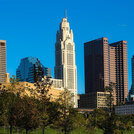
A statistical analysis of a 3D model of a Columbus, Ohio neighborhood estimated that if the neighborhood's trees were all mature, surface temperatures would be lowered by 3.48° F. 20 additional mature trees would lower temperatures by an additional 1.39° F. Based on their analysis, the researchers recommend that designers site new trees and new buildings to maximize the extent of shadows at at ground level and on building walls for maximum cooling effect.
Park, Yujin, Jean-Michel Guldmann, and Deshen Liu. “Impacts of Tree and Building Shades on the Urban Heat Island: Combining Remote Sensing, 3D Digital City and Spatial Regression Approaches.” Computers, Environment and Urban Systems 88 (2021): 131. https://doi.org/10.1016/j.compenvurbsys.2021.101655.
